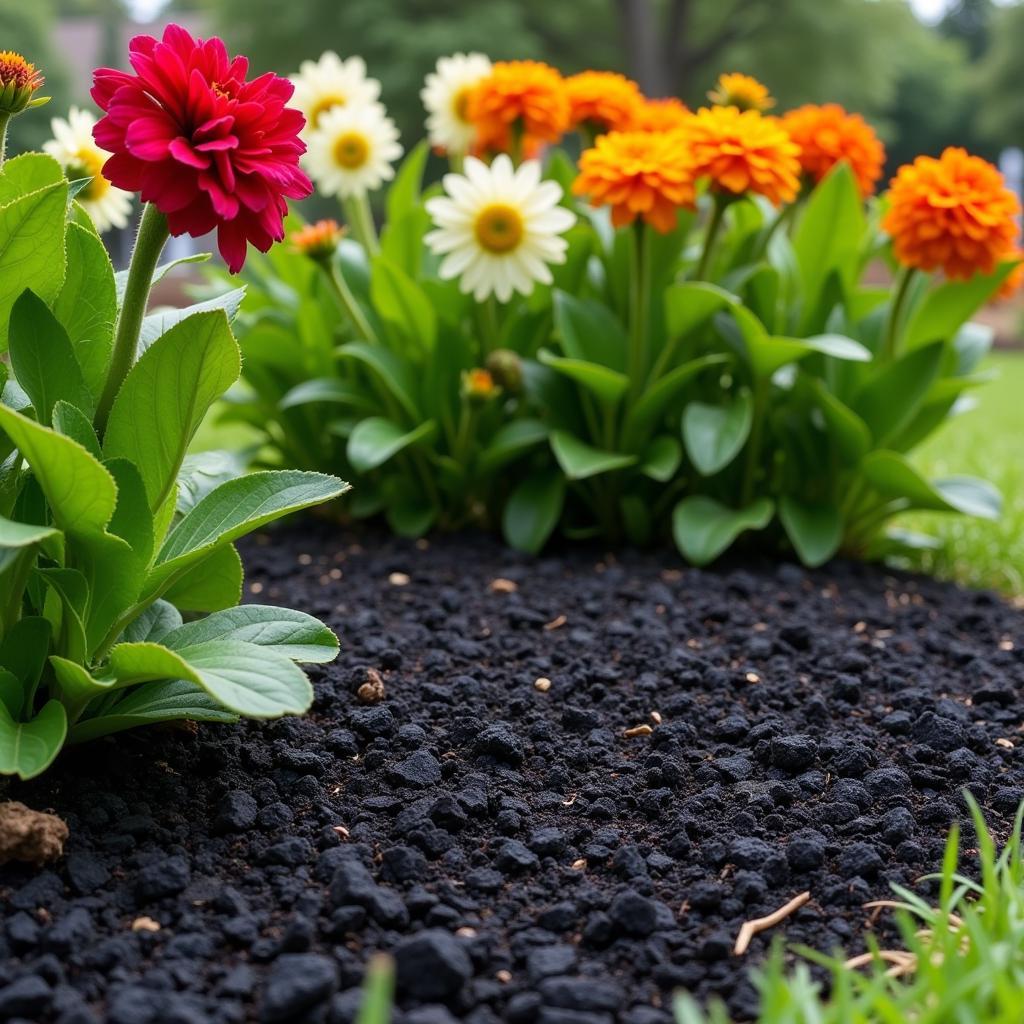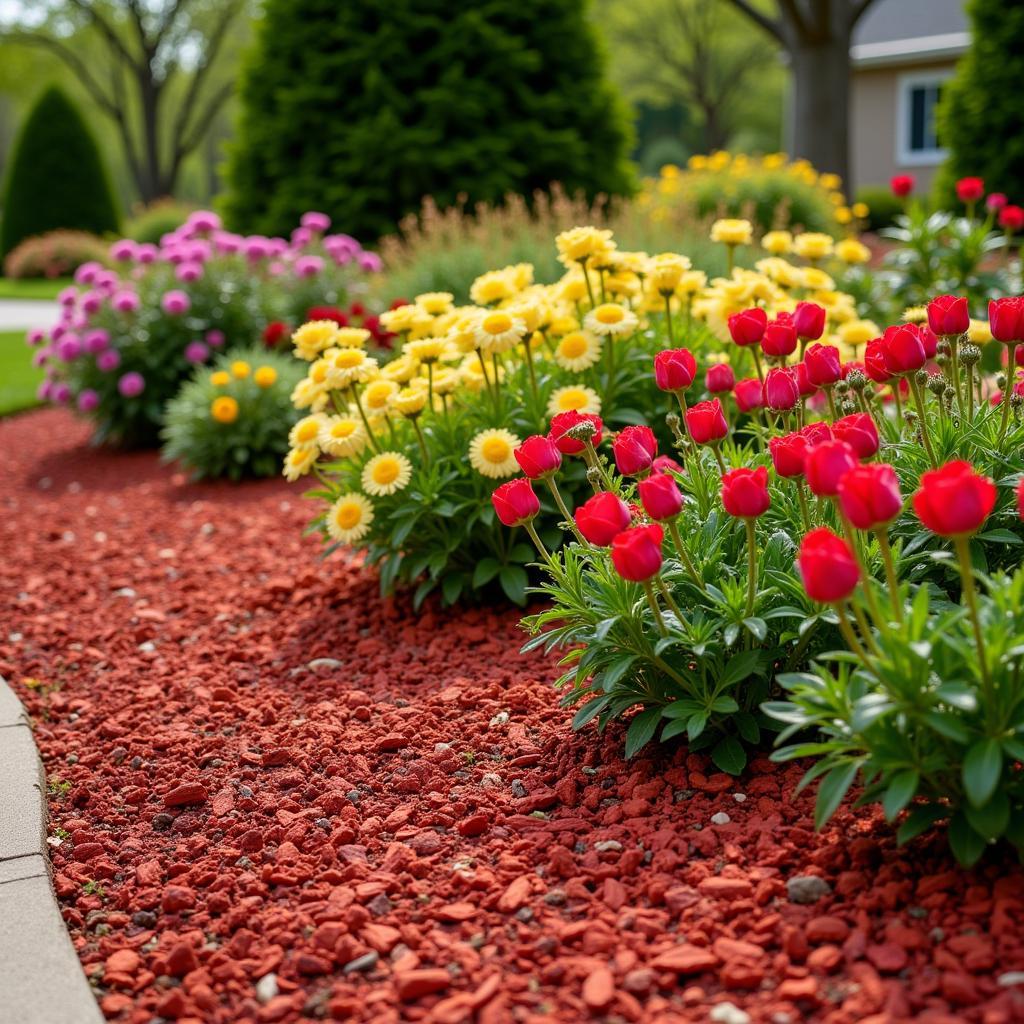Choosing the right mulch color can significantly impact your garden’s overall aesthetic. But with so many options available, deciding which mulch color is best can be overwhelming. This guide explores the various mulch color choices, their benefits, and how to select the perfect one to complement your plants and landscape design.
Understanding the Role of Mulch
Before diving into the color options, let’s understand why mulch is essential. Mulch plays a crucial role in maintaining a healthy and vibrant garden. It helps retain soil moisture, suppress weeds, regulate soil temperature, and prevent erosion. Over time, organic mulches break down, adding beneficial nutrients to the soil. Choosing the right mulch involves considering its functionality and aesthetic appeal.
Exploring Mulch Color Options
The most common mulch colors range from natural browns and blacks to reds and golds. Each color offers a unique look and can influence the overall ambiance of your garden.
Black Mulch
Black mulch provides a stark contrast against green foliage, making plants pop. It’s a popular choice for modern landscapes and can create a clean, polished look. However, black mulch can absorb more heat, potentially raising soil temperatures, which may not be ideal for all plants.
Brown Mulch
Brown mulch is a classic choice that blends seamlessly with most landscapes. It offers a natural, earthy appearance and mimics the look of decaying leaves. Brown mulches come in various shades, from light to dark, providing flexibility in design.
Red Mulch
Red mulch adds a vibrant touch to the garden. It can create a warm, inviting atmosphere and complements plants with red or purple foliage. However, the color can fade over time, requiring occasional replenishment to maintain its vibrancy.
Other Mulch Colors
Beyond the traditional options, you’ll find mulch in gold, cypress, and even dyed blue or green. These unique colors can create a dramatic statement in your garden, but consider their long-term impact and how they will interact with your existing landscape elements. Just like choosing the right exterior paint color for your house, mulch color selection requires careful planning. For advice on exterior house colors, you might find helpful information in which is the best matching color for gray house exterior.
 Black Mulch Creates Contrast in a Garden
Black Mulch Creates Contrast in a Garden
Which Mulch Color Is Best for My Plants?
The best mulch color depends on your specific plants and climate. Darker mulches absorb more heat, which can benefit cool-season crops but might be detrimental to heat-sensitive plants. Lighter mulches reflect sunlight, keeping the soil cooler.
What’s the best mulch for vegetables?
For vegetable gardens, dark brown or black mulch can help warm the soil, promoting faster growth. However, in hotter climates, lighter mulches might be preferable to prevent overheating. Similar to choosing the right planting time, mulch selection plays a vital role in successful gardening. If you’re interested in planting in Colorado, you can find useful information on when to plant potatoes colorado and how to plant garlic in colorado.
What about flower beds?
For flower beds, the best mulch color depends on the color of your flowers and the overall aesthetic you want to achieve. Contrasting colors can create a dramatic effect, while complementary colors can create a harmonious blend.
 Red Mulch Enhances a Vibrant Flower Bed
Red Mulch Enhances a Vibrant Flower Bed
Matching Mulch to Your Landscape
Choosing the right mulch color involves considering your overall landscape design. Do you have a modern, minimalist garden or a more traditional, rustic setting? The mulch color should complement your existing hardscaping, such as walkways and patios, and enhance the overall aesthetic of your outdoor space. Just like choosing the appropriate tree for your environment, selecting the right mulch enhances your landscape’s beauty and health. You can find information about growing magnolias in Colorado at do magnolia trees grow in colorado.
Choosing the Right Mulch: A Practical Guide
Here’s a step-by-step guide to selecting the perfect mulch color for your garden:
- Consider your plants: Determine if your plants prefer warm or cool soil temperatures.
- Assess your landscape: Think about the overall style and existing color scheme.
- Experiment with samples: Try small patches of different mulch colors to see how they look in your garden.
- Think about maintenance: Consider how often you’re willing to replenish the mulch. Some colors, like red, tend to fade faster.
- Choose high-quality mulch: Regardless of color, select high-quality mulch from a reputable supplier. You can also learn more about selecting the best mulch color at which color mulch is best.
Conclusion
Selecting the best mulch color is a crucial step in creating a beautiful and thriving garden. By considering your plants, landscape, and personal preferences, you can choose a mulch color that enhances your outdoor space and provides numerous benefits for your plants.
FAQ
-
Does mulch color affect plant growth? Indirectly, yes. Darker mulches absorb more heat, which can affect soil temperature and, consequently, plant growth.
-
How often should I replace mulch? It depends on the type of mulch. Organic mulches typically decompose within a year and need to be replenished annually.
-
Can I mix different mulch colors? Yes, you can experiment with mixing different mulch colors to create a unique look.
-
Is dyed mulch safe for plants? Most dyed mulches are safe for plants, but it’s always best to choose mulches from reputable suppliers.
-
What is the best mulch for weed control? Thick layers of any type of mulch can help suppress weeds.
-
How much mulch do I need? A general rule of thumb is to apply a 2-3 inch layer of mulch.
Need help choosing the perfect mulch color for your garden? Contact us at 0373298888, email us at [email protected], or visit us at 86 Cầu Giấy, Hà Nội. We have a 24/7 customer support team ready to assist you.
